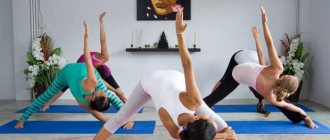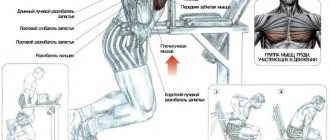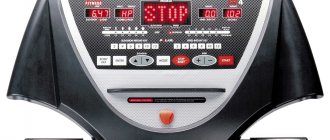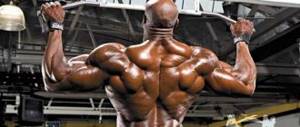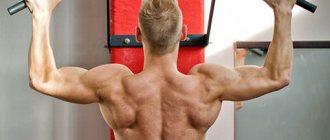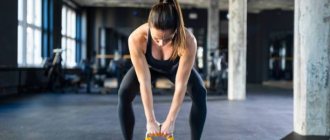Pumping up the triceps includes many exercises, one of which is dips. It is considered almost the most effective, but requires special training and proper execution. How to learn to do push-ups on parallel bars?
This type of push-up is universal and specializes in several muscle groups at once, namely: pectoral, deltoid and those that are part of the triceps (its upper part).
What muscles are involved?
Many athletes are interested in what dips do. And here we must report one interesting feature. This horizontal bar allows you to change the target muscle group by slightly adjusting the push-up technique. If desired, you can specifically load the triceps or just the pectoral muscles. There are also variations that require additional effort from the core muscles or a developed sense of balance.
It turns out that one simple simulator allows you to work out the entire upper shoulder girdle! So, what muscles are involved in the process of push-ups on uneven bars, let’s list:
- Triceps or triceps. It works in any subtype, but the athlete can adjust the load on it;
- Pectoralis major muscle. Subject to certain techniques;
- Front delts. Secondary load;
- Press;
- You can connect the biceps femoris and gluteus maximus if you bend your legs back and fix them in a stationary position;
- Stabilizer muscles;
Ligaments and joints also work actively. The elbow and wrist receive the heaviest load. They should be flexible and stretchable.
Dips are considered exercises with an increased risk of injury. If you have diseases associated with the condition of the joints, especially those mentioned above, it is better to avoid them. Below we provide a list of contraindications, as well as alternative types of physical activity.
Benefits and harms
Let's look at what dips do and what their benefits are:
- They allow you to build the perfect body. The exercise is also called the “upper body squat” for its effectiveness and variability;
- Increases the level of endurance;
- Makes muscles strong and elastic;
- Helps in building muscle mass (with push-ups with additional weight);
- They form self-esteem, increase physical fitness, and have a positive effect on the emotional state;
- Well, and everything useful that sport gives a person.
So, we have told you what the benefits of exercises on the uneven bars are, but there are also harms. Let's say more - such push-ups have a lot of opponents, and this is what their beliefs are based on:
- This sport is extremely dangerous. Beginners should only perform it under supervision;
- The technique cannot be called simple - there are a lot of nuances, failure to comply with which can easily lead to harmful consequences;
- The exercise places too aggressive a load on the arm joints;
As you can see, all the negativity is associated with an increased risk of injury. However, if you clearly know how to do dips on the uneven bars correctly, you will not have any problems. Study the technique, set yourself an adequate load and do not train if you are sick. Following these simple recommendations will significantly reduce all negative consequences.
The benefits of working with weights
Hanging weights such as metal chains, barbell plates and kettlebells from your legs can increase the load on the muscles of the sternum and arms. Weighting of body weight due to sports equipment increases the effectiveness of exercise while increasing the risk of injury.
To avoid damage to joints and ligaments, you need to start exercising with minimal weights. A beginner should try to train with a projectile whose weight does not exceed 5 kg. Gradually, this indicator needs to be increased, focusing on your own feelings.
Kinds
In this section we will list all the varieties of dips, and in the next we will tell you how to do them correctly.
- The classic version is the load on the triceps;
- With an emphasis on the pectoral muscles;
- Lying on the uneven bars (the lower part of the body is supported by weight or stands on a support);
- With additional weights (fixed on the back or on the belt);
- Corner push-ups;
- From the pillars;
- Upside down parallel bars;
- Reverse grip (palms facing out).
The last 4 are classified as advanced techniques; beginners are not recommended to use them. All existing risks here increase many times over, and therefore, first, master the classic variations perfectly.
Interesting facts and observations
Multiple Olympia champion Jay Cutler came up with a special version of the exercise in which the triceps are used to the fullest. He works in V-shaped bars with his back to the apparatus. This allows even with a wide back and massive arms. Cutler recommends partial repetitions for this exercise, especially if the lifter is lifting a significant amount of weight. He considers the full amplitude to be traumatic.
How to do push-ups correctly?
Want to know what the correct technique is for doing dips? Please review the instructions for each species listed.
Classic
Do a good warm-up. Never start strength training without warming up your muscles. Jump onto the horizontal bar, grasping the handles with a palms-inward grip. Starting position: vertical hang on the parallel bars with outstretched arms, elbows pointing straight back.
- As you inhale, begin to lower yourself smoothly, bending your elbows to a right angle. Do not spread them apart, press them against the body - imagine that you are squeezed between two walls;
- As you exhale, slowly rise up.
Classic push-ups are good to perform on narrow parallel bars. It is advisable not to straighten your elbows at the top point, so as not to take away the load from the triceps.
With an emphasis on the pectoralis major
Jump onto the machine, grip with your palms facing inward. Slightly change the starting position: while hanging, the body leans slightly forward, about 30°, and the elbows turn slightly and spread to the sides.
- As you inhale, begin to bend your elbow joints, spreading them apart;
- The lowest point of the exercise is when the elbows form a right angle;
- As you exhale, smoothly return to the starting position.
For this variation, you should find a wide horizontal bar. Maintain an inclined torso position throughout all stages. At the top point, do not straighten your elbows completely. We told you how to correctly perform push-ups on uneven bars using two basic techniques. Next, we will briefly explain the technique in advanced variations.
Lying on uneven bars
If you are interested in how to increase the benefits of dips, we recommend paying attention to this subtype. It will definitely burn more calories than the classic technique.
The athlete jumps onto the machine and forces the body to assume a horizontal position. Next, he begins to do push-ups, as if from the floor. At the same time, his hands remain on the bars, and his legs are completely deprived of support. He has the opportunity to lower his chest below the level of his hands, which is impossible in a classic push-up. If it’s difficult for you, you can fix your legs on a support, but its height should coincide with the level of the bars.
With weights
Additional weights should only be included in dip training if the athlete can confidently perform 20 repetitions in one approach.
The specificity of the exercise does not allow holding the weight in the hands or on the shoulders, so athletes secure it with special chains on the belt. You can also put a backpack on your back. The technique remains the same. What can be used as weight?
- Belt with chain;
- Power belt;
- Special vest;
- Wrestling belt;
- Thick chain with massive links;
- Backpack with weight plates.
The recommended weight increase step is +5 kg.
Corner push-ups
The athlete jumps onto the uneven bars and raises his legs so that they form a right angle with his body. During push-ups, the elbows are pressed to the body. The variation allows you to effectively load the quadriceps and abs.
From the pillars
In this version, the support for the hands is much less stable, and therefore the stabilizer muscles are more actively involved in the work.
Outward grip
A difficult type of exercise, because when the palms face outward, when lowering, the elbows will twist to the sides on their own. Considering that the athlete needs to keep his body suspended, the task is not an easy one.
Upside down
Aerobatics. The athlete jumps onto the uneven bars and takes a position upside down, raising his legs up. In addition to actually doing push-ups, he also needs to hold his torso, control his balance and balance. This type works the front deltoids and triceps.
Experienced
If you can already do a couple of dips, move on to this block. The goal is to learn how to perform 20 or more regular push-ups at a time. In parallel with increasing your performance in push-ups, do not forget other exercises for experienced ones in order to achieve versatile and maximally harmonious development.
Regular dips
Place your hands on the parallel bars, push your feet off the ground, and come out onto straight arms. Bend your knees slightly and move your pelvis back. In this position, the body will lean forward slightly, which will reduce the range of motion in the shoulder joints, protecting them from injury (A). Bend your elbows and lower yourself until your shoulders (the part of your arm from the elbow to the shoulder joint) are almost parallel to the floor (B). Do a push-up with your arms fully extended. Repeat.
Straight Leg Raise
Place your hands on the bars and come out with straight arms. Move your legs forward a little (A). Without changing the position of the body, raise your legs, slightly bent at the knees, to the horizontal or higher (B). Smoothly return to the starting position and repeat.
Alternate leg raises
Place your hands on the bars and come out with straight arms. Keep your legs and body vertical (A). Raise your right leg to horizontal or slightly higher (B). Lower it back to the starting position and lift your left leg (B). This is one repetition.
Corner turns
Stand on straight arms, then raise your legs slightly bent at the knees so that your feet are higher than the bars (A). From this position, slowly turn your body and legs, first to the right (B) and then to the left (C). When turning, try not to bend your elbows too much. This is one repetition.
Straight leg raises + corner turns
Stand on straight arms, bringing your legs slightly bent at the knees slightly forward (A). Smoothly lift your legs above the bars (B). Now, maintaining the resulting corner, turn first to the right (B) and then to the left (D). Return to the starting position with your legs down. Repeat.
Dips with corner
Stand on straight arms, then raise your legs slightly bent at the knees so that you get a right angle between your hips and body (A). Bend your elbows and lower yourself down, maintaining corner (B). Return to the starting position without lowering your legs and repeat.
Diagonal push-ups
Place your palms on the ground slightly wider than shoulder-width apart, and place your legs straight on the parallel bars, as shown in the photo. Make sure your body is in line with your legs (A). Without bending at the waist, bend your arms and lower yourself as close to the ground as possible (B). Return to straight arms and repeat.
Important This exercise is not recommended for people with cardiovascular health problems or visual impairment.
One-arm reverse pull-ups
Approach the bars from the side and grab the bar closest to you with your right palm from below, move your legs slightly forward, hold your free hand behind your back (A). Bend your left elbow and pull yourself toward the bar (B). Return to starting position and repeat. After doing the required number of repetitions with one hand, do the same number with the other.
Important While performing this exercise, do not bend at the lower back and do not sink your pelvis down.
Walking on your hands
Stand on straight arms (A) and walk on your hands, alternating them (B), to the end of the parallel bars. Jump to the ground, turn around and continue. One pass counts as one repetition.
Jumping on hands
Stand on straight arms (A). Jump 10–20 cm (B), trying to help yourself with your legs and not bend your elbows too much, move forward to the end of the bars. Jump to the ground, turn around and continue. One pass counts as one repetition.
How many times should you do push-ups?
Many athletes are interested in the parallel bars push-up schedule for beginners; we recommend adhering to the following scheme:
- Start the program with two sets of 10 reps. Exercise every other day so that your muscles have time to rest;
- If you feel that the execution is easy, increase the number of repetitions by 5 push-ups;
- After a week, you can increase the number of approaches to 3.
After a month, you should do 4 sets of 30 push-ups, no less. Starting from the second month, you can do push-ups on the uneven bars every day. Additional weight is added when the load is no longer felt much. Add no more than 5 kg each time.
If you don't know how to start doing dips from scratch, first pump up the target muscles with standard push-ups. The body must be ready for increased stress, otherwise everything will end sadly for you.
Remember, the answer to the question “how many times should you do push-ups on the uneven bars” will be individual for each athlete. This depends on his level of physical fitness, the condition of the target muscles, age, emotional state, etc. The diagram we have given is approximate, and there is nothing terrible in the fact that you slightly adjust it to suit yourself. The most important thing is to study systematically and without skipping. And don't stop there.
Inclusion in the program
We have before us a complex but very useful movement. This exercise requires full concentration on technique and “fresh” muscles. It makes sense to put it first in a training program focused on bulking or cutting, and second for strength athletes. If the priority is the bench press, perform the competition movement first and then the parallel bars. For bodybuilders, everything can be exactly the opposite. The number of repetitions is determined by the athlete's individual response to the load. The more repetitions, the lighter the weight will be. Most athletes require no more than 3 working sets of 10-20 repetitions.
The training program is compiled depending on the goals, some do not need to add weights, but static dynamics are shown, for others it’s the other way around. Strength programs can include 4-6 rep sets of push-ups.
Common mistakes in technology
We found out why push-ups on parallel bars are useful, and also warned that if performed incorrectly, the athlete can easily harm himself. Check out the most common mistakes that almost every beginner makes:
- Throughout the entire approach, you cannot round your back, even if you perform the option with a tilt of the body;
- Make sure your grip is tight and strong. The palm should not “ride” along the handle;
- Avoid jerking and sudden movements;
- Do not sag in the top or bottom positions;
- Do not straighten your elbows completely at the top.
Abs exercise
To work your abdominal muscles, you need to sit on one bar and place your legs under the other.
- Lean back, keeping your back straight and crossing your arms over your chest. As soon as you deviate from the vertical, the abdominal muscles come into play. Thanks to them, you hold your body throughout the entire movement.
- At the bottom point, do not arch your back.
- Rise until your body is vertical.
When performing this exercise, be careful to firmly grip the second bar with your feet and control the position of your back.
Triceps and chest push-ups, as well as sit-ups, are the main exercises performed on the parallel bars. Bars will not be enough to work other muscles. Therefore, do not forget about the horizontal bar, dumbbells and other methods of training.
How to increase the number of repetitions?
If you are interested in how to increase the number of dips on the parallel bars, we will say only one thing - work efficiently. Don't skip classes, lift the load regularly, build muscle strength. So, here's what we can advise in this case:
- Diligence and hard work;
- Motivate yourself well;
- When you finish your approach, do not rush to immediately jump off the horizontal bar. Hang slightly without straightening your elbows. Let the muscles work a little more statically;
- Don’t forget about other types of push-ups - they all perfectly strengthen the necessary muscles.
How to replace dips?
Not everyone can do dips from scratch, so many novice athletes are interested in what can temporarily replace them.
First, you can always do classic push-ups. At home, you can put two chairs and raise your legs to a right angle with your body. Or simply place them on the surface, bending your knees. This option is also suitable for girls, as it is considered lightweight. You can also try push-ups with your fists or dumbbells. While working, press your elbows tightly against your body - this way you will imitate the desired technique as accurately as possible.
Our publication has come to an end, we have considered the topic of push-ups on uneven bars, as they say, from A to Z. We also recommend watching video instructions on Youtube - so you will see everything that was said above clearly. Make sure that you have no contraindications and do not try to break the world record in the first week. By the way, it belongs to the British Simon Kent, who was able to do as many as 3989 push-ups in an hour! The record has not been broken for more than 20 years.
Training for mass gain
The growth of muscle mass directly depends on the time that muscle fibers spend under load. So lift and lower your body slowly.
- Exercise number one is, of course, classic dips.
- You can also perform horizontal push-ups with this tool. The athlete's legs and arms are placed on the bars, they are performed as on the ground, only they have a significant advantage - the ability to increase the amplitude of movement by bending below the bars.
- Naturally, training alone will not be enough to gain muscle mass. You will also need proper nutrition and proper rest.
- To work on mass, you will need to do 5 sets of maximum repetitions without weights. Rest between sets should not be more than 3 minutes. With weights there are also 5 approaches, only 5 repetitions each.
For maximum results, use different widths of the projectile, position of the arms and body, depending on which muscle group you want to pump at the moment.
